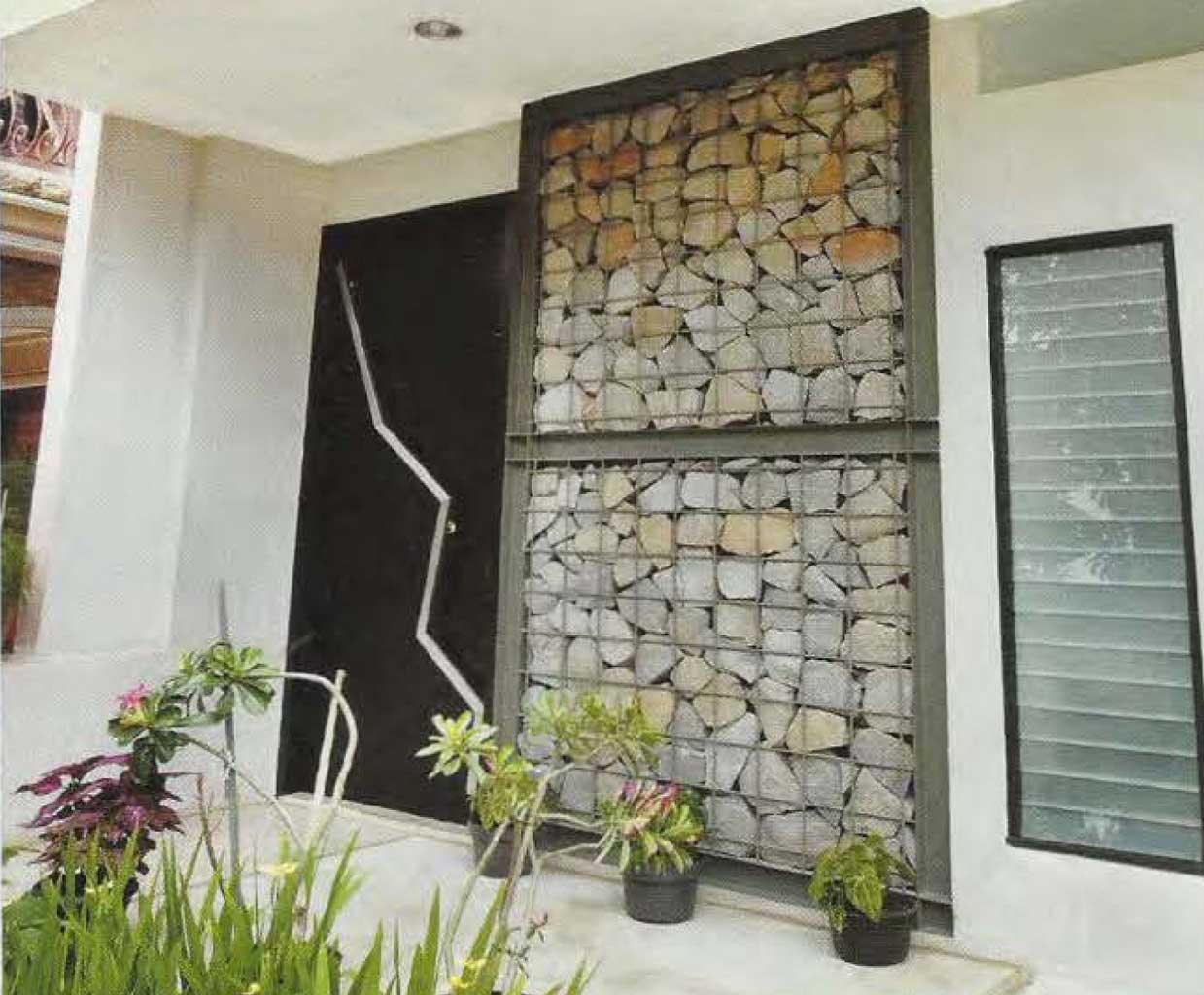19 Tips and Tricks to Build a House Projects and Finish It! | Roy Home Design
When building a house or garden, there are often obstacles that confront. In order to make your build your own home project more smoothly, here are the tips and tricks!
Make a Vertical Garden
Determine the dimensions of the wall for the plant area. Select areas that are exposed to sunlight or facing to the source pollution.
- Build several racks for the planter box. It is better to keep the bottom rack above the ground so that excess water can directly drip and absorbed into the soil. Spread some gravels at the bottom of the rack or make a gutter to drain the water to the ground.
- If the wall is pretty high and it’s hard for the watering process, prepare a watering installation. This installation can be a pipe or a perforated hose.
- Plan the size of the rack. Usually, the standard size of border plants / short shrubs from 20 cm x 20 cm to 30 cm x 60 cm. Choose plants that are suitable for the planter box. The plant media can be chosen that is lightweight so as not to overload the rack and are easily maintained, such as gels, coconut fiber, stem ferns, grass, charcoal, and husks.
- Choose a pot/planter box with lightweight material, like plastic. Don’t hesitate to experiment with various colors and textures so the pot looks unique.
- In the market, a planter wall garden has been circulating that allows plants to be planted horizontally, so the walls are covered with plants. The selected plants do not have to be vines / dangling plants.
See also: Vegetable Home Garden Plans for Beginner Gardener
Air Circulation in the Duplex House
The main problem that is often found in duplex house designs is the poor air circulation. The air only enters through the opening area in the front and the back of the house, not flowing in the opposite direction. To prevent the air inside the house from becoming stuffy, there are 4 tricks that can be tried.
-
- Make a cross vent that is connected directly to the outside of the house, so that air can rotate from inside to outside the house and vice versa. The opening area can be a window or lattice with proportional size and enough to flow the air.
- Pay attention to the slope of the roof and the type of cover material. The most appropriate slope is from 30 to 45. The size of the roof slope affects the air quality in the house. The higher the roof houses, the lower the sun’s radiation. The heat will be trapped in the roof, so that the inside of the house is protected from heat.
- If your roof is flat, you can cover it with aluminum foil. Unlike the metal material that absorbs heat, aluminum foil instead reflects sunlight and keep the area inside the house remains cool. Installing it is also easy, the aluminum foil just mounted on the purlin beam, then tied with nails and mounted on the ceiling.
- Use heat barrier insulator material. For example, solar panels, exhaust fans, or turbine ventilators. Good air quality not only makes you feel comfortable in the house, but also maintains the health of all family members.
-
Vines for Canopies
One easy way to make a natural-looking canopy is to use vines. The media for propagation can be made from wire formed as desired. For the plant type, there are several types of vines that are suitable to be used as canopies.
-
- Mandevilla. The flowers are facing upwards, red, white or pink colored. It is horizontal propagating, so it can cover the canopy media thoroughly.
- Alamanda. The flowers are yellow with buds facing down. Propagate in the upper surface, so that the bottom is only a leafless stem.
- Thunbergia. The flowers hang downward with purple and white color options. Long propagate with the tip of the plant dangling down.
- Ipomoea. The flowers are purple or white. The vines grow upright and can cover the entire surface of the canopy thoroughly.
Replant the Trees
Move the tree from its original location to the new area you want might look simple. However, problems sometimes occur in this process. The moved tree withers or even slowly dies. There are certain techniques for keeping trees growing and can adapt to conditions in their new place, here are the tips.
-
- Before digging the roots of the tree to be moved, watering the soil around it. The digging process will be easier and the root of the tree does not need to be forcibly pulled out. The root width of the tree is equal to the width of the diameter of the tree canopy. Try to multiply that width, so that not many roots are damaged. Dig to a depth of at least 60 cm from the ground surface.
- Before the tree is moved, wrap the roots with a sack. Do not dispose of soil attached to the tree roots. Plant the trees in a new location. Rooting must be planted entirely. Place the support beam firmly so that the tree is stable. If the tree is still often unsteady, it’s mean the root is not strong. This will disrupt its growth. Give fertilizer to stimulate the root growth and water the plant 2 times a day.
-
Coconut Fibers for Vertical Garden
Maria Renata, a landscape designer, has a pretty unique idea in making a vertical garden, which is by utilizing coconut fibers. Coconut fibers are woven into sheets with sizes that are adjusted to the surface of the wall. Coconut fibers have a dual function, as a planting medium as well as a wrapper medium. In these coconut fiber sheets, the plants will be installed by tied together with the surface. The variation of stacking patterns and interweaving coconut fibers will add to the aesthetic value of the vertical garden, very creative!
See also: Why Indoor Garden in Minimalist Tropical House so Famous?
-
Choosing Raw Wood
Raw wood can be used as a unique partition in the house. Having a wavy stem makes the house look natural. To get quality raw wood, look for the following features:
-
- Old enough,
- Coarse-textured with firmer fibers,
- Have a large diameter,
- The cross-section diameter does not crack,
- The color is dark brown because it’s aged.
Creating Thermal Comfort
Humans will feel comfortable if the room temperature is in the range of 21 °C – 27 °C with air humidity 40% – 70%. To achieve this condition, Joseph Kewell, an expert in thermal comfort, has 4 suggestions that you can apply at home.
- Create an open space on the front and back sides of the roof to create cross ventilation. If the back wall of your house is attached to the neighboring wall, you can make openings on the roof, while the room below can be used as a dry garden.
- Create openings or gaps between the roof and the wall. This gap will function as a cool and hot air exchange path, so that the hot air will not be trapped between the roof and the ceiling.
- Make a high ceiling, ideally 3 m – 3,2 m. High ceilings will reduce the influence of heat propagation from the roof to the room interior below it.
- Install the openings, can be a roster or bouvenlicht, at the top of the wall. The upper opening serves to release hot air that moves upward the room.
-
Making Stone Walls
Stone walls can be used as a sturdy room divider or attractive decorations. It is better to make the wall area not too high so that the arrangement does not need to be given a binder (cement) and rely on the strength of the wire mesh (wire basket). Use electric welding to connect the metal frame, so wire mesh can withstand the load. Wiremesh material motifs can be adjusted to the design of the house. To clean the stone, avoid using water so that the iron material does not rust. You can use a dry cloth to remove dust.
See also: Wall Paint Ideas to Create Perfect Home Wall Decor
So, if you’d like to have the great graphics regarding 19 Tips and Tricks to Build a House Projects and Finish It!, simply click save link to save the pics for your personal computer. These are ready for save, if you like and wish to have it, click save logo on the page, and it will be instantly saved in your laptop.
Thanks for visiting Royhomedesign.com, article above 19 Tips and Tricks to Build a House Projects and Finish It! published. Lots of people trying to find info about Build a House and of course one of them is you, is not it?





